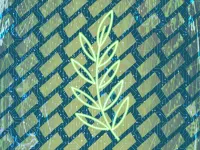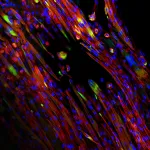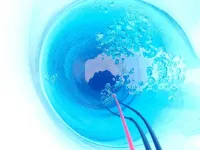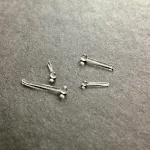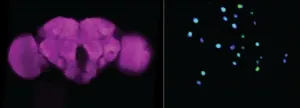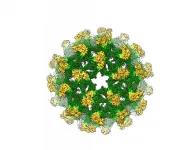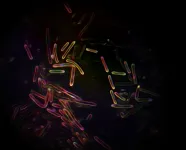(Press-News.org) Inspired by nature, researchers at Pacific Northwest National Laboratory (PNNL), along with collaborators from Washington State University, created a novel material capable of capturing light energy. This material provides a highly efficient artificial light-harvesting system with potential applications in photovoltaics and bioimaging.
The research provides a foundation for overcoming the difficult challenges involved in the creation of hierarchical functional organic-inorganic hybrid materials. Nature provides beautiful examples of hierarchically structured hybrid materials such as bones and teeth. These materials typically showcase a precise atomic arrangement that allows them to achieve many exceptional properties, such as increased strength and toughness.
PNNL materials scientist Chun-Long Chen, corresponding author of this study, and his collaborators created a new material that reflects the structural and functional complexity of natural hybrid materials. This material combines the programmability of a protein-like synthetic molecule with the complexity of a silicate-based nanocluster to create a new class of highly robust nanocrystals. They then programmed this 2D hybrid material to create a highly efficient artificial light-harvesting system.
"The sun is the most important energy source we have," said Chen. "We wanted to see if we could program our hybrid nanocrystals to harvest light energy--much like natural plants and photosynthetic bacteria can--while achieving a high robustness and processibility seen in synthetic systems." The results of this study were published May 14, 2021, in Science Advances.
Big dreams, tiny crystals
Though these types of hierarchically structured materials are exceptionally difficult to create, Chen's multidisciplinary team of scientists combined their expert knowledge to synthesize a sequence-defined molecule capable of forming such an arrangement. The researchers created an altered protein-like structure, called a peptoid, and attached a precise silicate-based cage-like structure (abbreviated POSS) to one end of it. They then found that, under the right conditions, they could induce these molecules to self-assemble into perfectly shaped crystals of 2D nanosheets. This created another layer of cell-membrane-like complexity similar to that seen in natural hierarchical structures while retaining the high stability and enhanced mechanical properties of the individual molecules.
"As a materials scientist, nature provides me with a lot of inspiration" said Chen. "Whenever I want to design a molecule to do something specific, such as act as a drug delivery vehicle, I can almost always find a natural example to model my designs after."
Designing bio-inspired materials
Once the team successfully created these POSS-peptoid nanocrystals and demonstrated their unique properties including high programmability, they then set out to exploit these properties. They programmed the material to include special functional groups at specific locations and intermolecular distances. Because these nanocrystals combine the strength and stability of POSS with the variability of the peptoid building block, the programming possibilities were endless.
Once again looking to nature for inspiration, the scientists created a system that could capture light energy much in the way pigments found in plants do. They added pairs of special "donor" molecules and cage-like structures that could bind an "acceptor" molecule at precise locations within the nanocrystal. The donor molecules absorb light at a specific wavelength and transfer the light energy to the acceptor molecules. The acceptor molecules then emit light at a different wavelength. This newly created system displayed an energy transfer efficiency of over 96%, making it one of the most efficient aqueous light-harvesting systems of its kind reported thus far.
Demonstrating the uses of POSS-peptoids for light harvesting
To showcase the use of this system, the researchers then inserted the nanocrystals into live human cells as a biocompatible probe for live cell imaging. When light of a certain color shines on the cells and the acceptor molecules are present, the cells emit a light of a different color. When the acceptor molecules are absent, the color change is not observed. Though the team only demonstrated the usefulness of this system for live cell imaging so far, the enhanced properties and high programmability of this 2D hybrid material leads them to believe this is one of many applications.
"Though this research is still in its early stages, the unique structural features and high energy transfer of POSS-peptoid 2D nanocrystals have the potential to be applied to many different systems, from photovoltaics to photocatalysis," said Chen. He and his colleagues will continue to explore avenues for application of this new hybrid material.
INFORMATION:
Other authors of this study include: James De Yoreo, Mingming Wang, Shuai Zhang, and Xin Zhang from PNNL and Song Yang and Yuehe Lin from Washington State University. Shuai Zhang, James De Yoreo, and Chun-Long Chen are also affiliated with the University of Washington. This work was supported by the U.S. Department of Energy Basic Energy Sciences program as part of the Center for the Science of Synthesis Across Scales, an Energy Frontier Research Center located at the University of Washington.
HOUSTON - (May 14, 2021) - Rice University bioengineers are fabricating and testing tunable electrospun scaffolds completely derived from decellularized skeletal muscle to promote the regeneration of injured skeletal muscle.
Their paper in Science Advances shows how natural extracellular matrix can be made to mimic native skeletal muscle and direct the alignment, growth and differentiation of myotubes, one of the building blocks of skeletal muscle. The bioactive scaffolds are made in the lab via electrospinning, a high-throughput process that can produce single micron-scale fibers.
The research could ease the burden of performing an estimated ...
Scientists have used fibre-optic sensing to obtain the most detailed measurements of ice properties ever taken on the Greenland Ice Sheet. Their findings will be used to make more accurate models of the future movement of the world's second-largest ice sheet, as the effects of climate change continue to accelerate.
The research team, led by the University of Cambridge, used a new technique in which laser pulses are transmitted in a fibre-optic cable to obtain highly detailed temperature measurements from the surface of the ice sheet all the way to the base, more than 1000 metres below.
In contrast to previous studies, which measured temperature from separate sensors located tens or even hundreds of metres apart, the new approach allows temperature ...
A microscope used by Antoni van Leeuwenhoek to conduct pioneering research contains a surprisingly ordinary lens, as new research by Rijksmuseum Boerhaave Leiden and TU Delft shows. It is a remarkable finding, because Van Leeuwenhoek (1632-1723) led other scientists to believe that his instruments were exceptional. Consequently, there has been speculation about his method for making lenses for more than three centuries. The results of this study were published in Science Advances on May 14.
Previous research carried out in 2018 already indicated that some of Van Leeuwenhoek's microscopes contained common ground lenses. Researchers have now examined ...
In research made possible when COVID-19 sidelined other research projects, scientists at Johns Hopkins Medicine meticulously counted brain cells in fruit flies and three species of mosquitos, revealing a number that would surprise many people outside the science world.
The insects' tiny brains, on average, have about 200,000 neurons and other cells, they say. By comparison, a human brain has 86 billion neurons, and a rodent brain contains about 12 billion. The figure probably represents a "floor" for the number needed to perform the bugs' complex behaviors.
"Even though these brains are simple [in contrast to mammalian brains], they can do a lot of processing, even more than a supercomputer," says Christopher Potter, Ph.D., associate professor of neuroscience ...
Being treated fairly is important - but fairness alone isn't enough to make people feel valued in a workplace or other groups, new research suggests.
Researchers found that "distinctive treatment" - where a person's talents and qualities are recognised - provides this sense of value while also reinforcing their sense of inclusion. It also promotes mental health.
The findings suggest there is no conflict between "fitting in" and "standing out" in groups - in fact, they complement each other.
But while the importance of fairness is widely accepted, the researchers say distinctive treatment is ...
AMES, Iowa - The field photos show the hard, rough country that some glaciers slide over: rocky domes and bumps in granite, rocky steps and depressions in limestone. The glacier beds dwarf the researchers and their instruments. (As do the high mountains pictured on the various horizons.)
During their trips to glacier beds recently exposed by retreating glaciers in the Swiss Alps (Rhone, Schwarzburg and Tsanfleuron glaciers) and the Canadian Rockies (Castleguard Glacier), four glaciologists used laser and drone technology to precisely measure the rocky beds and record their very different contours.
The researchers turned the measurements into high-resolution digital models of those glacier beds. Then they went to work with manageable but representative subunits of the ...
Better designed vaccines for insect-spread viruses like dengue and Zika are likely after researchers discovered models of immature flavivirus particles were originally misinterpreted.
Researchers from The University of Queensland and Monash University have now determined the first complete 3D molecular structure of the immature flavivirus, revealing an unexpected organisation.
UQ researcher Associate Professor Daniel Watterson said the team was studying the insect-specific Binjari virus when they made the discovery.
"We were using Australia's safe-to-handle Binjari virus, which we combine with more dangerous viral genes to make safer and more effective vaccines," Dr Watterson ...
ITHACA, NY, May 13, 2021 -- Cyanobacteria are one of the unsung heroes of life on Earth. They first evolved to perform photosynthesis about 2.4 billion years ago, pumping tons of oxygen into the atmosphere - a period known as the Great Oxygenation Event - which enabled the evolution of multicellular life forms.
Led by BTI faculty member END ...
The United States has witnessed a steep rise in reports, arrests, and media coverage of teachers' sexual misconduct with students. A new study investigated the impact of perpetrators' gender, sexuality, and age on perceptions of teacher sexual misconduct. The study found that
responses to teachers' misconduct varied according to certain characteristics, which can influence whether victims report the misconduct.
The study, by researchers at Prairie View A&M University and the University of Nevada, Reno, appears in Feminist Criminology.
"Because sexual abuse of a child or adolescent in any context has substantial psychological, emotional, and physical consequences for the victim, teachers' sexual misconduct is a serious public health ...
Developing self-healing materials is nothing new for Nancy Sottos, lead of the Autonomous Materials Systems Group at the END ...
